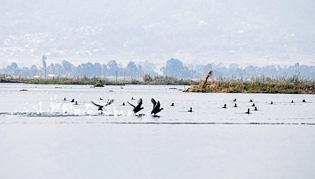Ithai Barrage posing big threat to Loktak Lake
Source: The Sangai Express
Imphal, February 08 2021:
Loktak Lake is deteriorating mainly because of the Ithai Barrage.
The barrage not only poses a threat to the lake but it is also threatening the Sangai on the Keibul Lamjao National Park, said locals and forest officials.
A team of journalists including this reporter had visited the lake and several areas including the Ithai Barrage on Friday as part of the "Know Your Sanctuaries and Wetlands" media campaign organised by the Department of Forest and Environment and Climate Change in association with All Manipur Working Journalists' Union (AMWJU) .
The journalists visited Keibul, Keibul Sangram, Khordak, Champu Khangpok at Langolsabi near Loktak and Ithai barrage.
N Birchandra, Range Forest Officer at the Keibul Lamjao National Park said the park floating on the largest freshwater lake in the North East India is about 40 square kilometres while the lake itself is about 236 sq kms in area.
Various threats pose danger to the survival of the Sangai and its natural habitat.
|
One of the main factors that threaten the Sangai is Ithai Barrage.
As a result of this barrage, the Phumdis (floating biomass) are becoming thinner which is not good for the Sangais, he said.
He also stated that human encroachment and illegal hunting on the lake and inside the park also threaten the survival of the Sangai.
There are more encroachers on the northern side of the park, he added.
The Range Forest officer said the park is being manned by a total of 45 staff including 20 regular and 25 casual ones.
Staff from the nearby areas are more handy in operating boats and they respond to any distress inside the park.
Even though they are prepared, the park lacks adequate and proper equipment to face fire, he said.
On Sangai, Birchandra said according to 2016-17 census, there are about 260 Sangais.
New census of the Sangai population is yet to be conducted.
The census is likely to be conducted after the COVID-19 situation improves, he said.
Nowadays, there is not much illegal hunting inside the park as people are more aware of the value of the park and the wildlife.
Proper awareness and education about the environment and wildlife among the people is still needed.
They should be brought on board in saving the park and the Sangais to effectively curb illegal hunting and human encroachment, he said.
Casual staff from Keibul, Ningthoujam Chandrakumar said, "We have come across people entering the park with hunting guns.
Sometimes, they threaten us.
Casual staff also work the same as regular staff.
We will be thankful if we are regularised".
The journalists then went on boat (canoes) from Thanga towards Yangoi river and Langolsabi.
Nambol and Nambul rivers meet at Yangoi Karong and form the Yagoi river which falls into Loktak Lake.
When they sailed from Loktak towards Yangoi, they found the waterways filled with waste and tall grasses and as a result they couldn't reach Yangoi Karong.
At the Champu Khangpok, local fisherman Oinam Nabachandra said the fishermen are being accused of polluting the lake which is not true.
The lake is being polluted and threatened by the Ithai Barrage.
The barrage is affecting the natural process, the lake does to clean itself, he said.
Once found abundantly, many fish species are no longer found in the lake due to the Ithai Barrage.
Fishes such as Ngamu, Ngaton, Khabak, Sareng and Ngasep are longer found in the lake.
Beside these fishes, Heikak and Wainu Chara (a local rice species) have also gone extinct, he added.
Further, about 36 rivers fall into the lake.
Among these, the Nambul river which runs through Imphal is causing the most harm to the lake.
There are about 165 households at Champu Khangpok.
Locals have put a ban on littering polythene and plastics in the lake.
Also, there is a ban on fishing using LED bulbs at night during migratory birds season and fish breeding season, he said.








